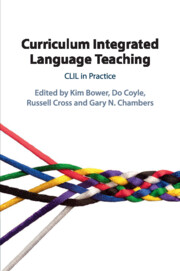Book contents
- Curriculum Integrated Language Teaching
- Curriculum Integrated Language Teaching
- Copyright page
- Contents
- Figures
- Tables
- Contributors
- Foreword
- Preface
- Acknowledgements
- Part I The Educational Context for CLIL
- Part II Current Aspects of Practice in CLIL
- 4 What Pupils Say about Transition (KS2–3) and What This Might Mean for CLIL
- 5 Diversity and Transnationalism
- 6 Three Schools, Three Models
- 7 Plurilingualism in the Content and Language Integrated Classroom
- Part III New Knowledge and Future Directions
- Afterword
- Index
- References
6 - Three Schools, Three Models
Senior Leaders’ Views about the Value of CLIL in Their School
from Part II - Current Aspects of Practice in CLIL
Published online by Cambridge University Press: 27 July 2020
- Curriculum Integrated Language Teaching
- Curriculum Integrated Language Teaching
- Copyright page
- Contents
- Figures
- Tables
- Contributors
- Foreword
- Preface
- Acknowledgements
- Part I The Educational Context for CLIL
- Part II Current Aspects of Practice in CLIL
- 4 What Pupils Say about Transition (KS2–3) and What This Might Mean for CLIL
- 5 Diversity and Transnationalism
- 6 Three Schools, Three Models
- 7 Plurilingualism in the Content and Language Integrated Classroom
- Part III New Knowledge and Future Directions
- Afterword
- Index
- References
Summary
This chapter addresses the book’s questions about how different models of CLIL can be implemented and why school leaders adapt their curriculum to include CLIL projects, set against the absence of a national policy for modern languages and a resulting paucity of cross-curricular language learning in the secondary sector. I begin by reviewing a range of models undertaken in schools before focusing on three more substantial models in this study and exploring school leaders’ rationale for CLIL and how they implemented the approach in their school. It draws on findings from the empirical research study referred to in Chapter 2, which investigated the extent to which CLIL promotes learner motivation in England and explored the transferability of CLIL to other schools. Leaders’ perceptions of, confidence in and professional commitment to CLIL in three contrasting models and settings are explored.
- Type
- Chapter
- Information
- Curriculum Integrated Language TeachingCLIL in Practice, pp. 107 - 123Publisher: Cambridge University PressPrint publication year: 2020



